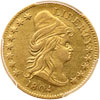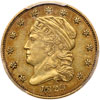
|
Sale 87
September Pre Long Beach
| Lot |
Photo |
Description |
Realized |
Lot 1344 |
 |
1798. Wide Date BD-2 Rarity 5. NGC graded AU-55. A nice untoned example of this elusive rarity.The strike is sharp and the surfaces are most handsome, with minimal signs of handling and precious little wear. As a type, the Capped Bust quarter eagles are downright rare, they are seldom offered or seen and the numbers minted were tiny. John Dannreuther in his book on gold varieties estimates that only 480 to 838 were struck of this die pairing. From that meager beginning a scant 45 to 55 examples survived at all. This is one of the finer pieces to exist.
It is interesting that these early gold coins offered no stated value on the coins themselves. Certain coins in this period did, often on the edges where their value was noted, or in fractions as on the copper coins. The larger silver coins did have values noted, starting with the quarter dollars of 1804, the half dollars on their edges beginning in 1794 along with the silver dollars in that year. Why there was no value notation on gold coins is not recorded. Although back when these 1798 quarter eagles were struck, there was quite a variety of coinage in circulation in the United States, much of it England and Europe along with Spanish coins. These were all weighed when used for transactions, and merchants all kept balance scales and weights to properly determine the value of the coins being tendered. Hence the "value" of a quarter eagle we determined by its weight on the scale, with a known purity common to other coins in circulation in that era.
Another fact that is most interesting is that the reverse dies used to strike these quarter eagles were also used to strike dimes as they were virtually the same size. Perhaps this explains why no denomination or value was used on these dies. Die sharing across denominations was a matter of efficiency, but was only known to have been used on these quarter eagles and dimes through 1807.
There are far more reasons to own one of these prized quarter eagles than not, they offer legendary rarity and are usually found in high grades. Their designs are captivating, and offer hours of intricate study with a magnifier. Each die was hand engraved after using the head punch and eagle punch first, then the dies were laid out with letters, the date and stars. Sometimes stars were slightly double punched when tapped into position on the die itself and these traces give a personal feel to each of the coins struck, as you can see the engraving touches and challenges. As such these Capped Bust quarter eagles are delightful to own, why not start with this scarce issue today? (PCGS # 7649) .
Estimated Value $25,000 - 30,000.
View details and enlarged photos
Check results on similar lots
| Unsold |
Lot 1345 |
 |
1804. 14 stars on reverse. BD-2, Rarity 4. PCGS graded AU-53. Well struck and lightly toned. There are a couple of minor adjustment marks on the reverse, but the color is a unform orange gold and traces of luster survive in the protected areas. The obvese and reverse designs are well excecuted and show just a bit of wear on the highest points of the design. This is one of the toughest type issues to find at all, mintages were tine and the numbers known today are paltry. Furthermore, this one has one of the most coveted dates in American numismatics, the magical year of 1804. Jefferson was President and beginning his second term in office, and the Lousiana Purchase had been completed. This classic rarity was there to bear witness to so much of our early history! Pop 9; 46 finer at PCGS. (PCGS # 7652) .
Estimated Value $14,000 - 16,000.
View details and enlarged photos
Check results on similar lots
| Realized
$16,744 |
Lot 1346 |
 |
1829. PCGS graded AU-50. CAC Approved. First year of the Capped Bust, Small Dentils type. A choice example for the grade, lightly toned with some rose color around the borders. Only 3,403 struck, with about 75 to 125 examples estimated to have survived. Handsome toning over natural yellow gold surfaces. The strike is sharp throughout and this one shows only light circulation evidence. The surfaces are pleasing too, with no deep or detracting marks.
Why are these so rare? The gold value of these had risen to the point that melting these gold coins was profitable. Hence many did just that, buy up all they could find and melt them down for the profit. This decimated the original mintages and today most of these issues are represented by far less than 1 percent of those struck. Its amazing that some dates weren't entirely eliminated! Today there are enough around that these are highly collectible, but for a price, as type collectors seeking an example keeps pressure on the handful of these that cross the market from year to year. By 1834 the situation became to so bad that an adjustment was made to the gold weight of each denomination in order to halt the future melting of the new coins for a profit. These old tenor coins were survivors and precious few are around today because of these tribulations. Pop 5; 43 finer at PCGS. (PCGS # 7669) .
Estimated Value $8,000 - 9,000.
View details and enlarged photos
Check results on similar lots
| Unsold |
|
|